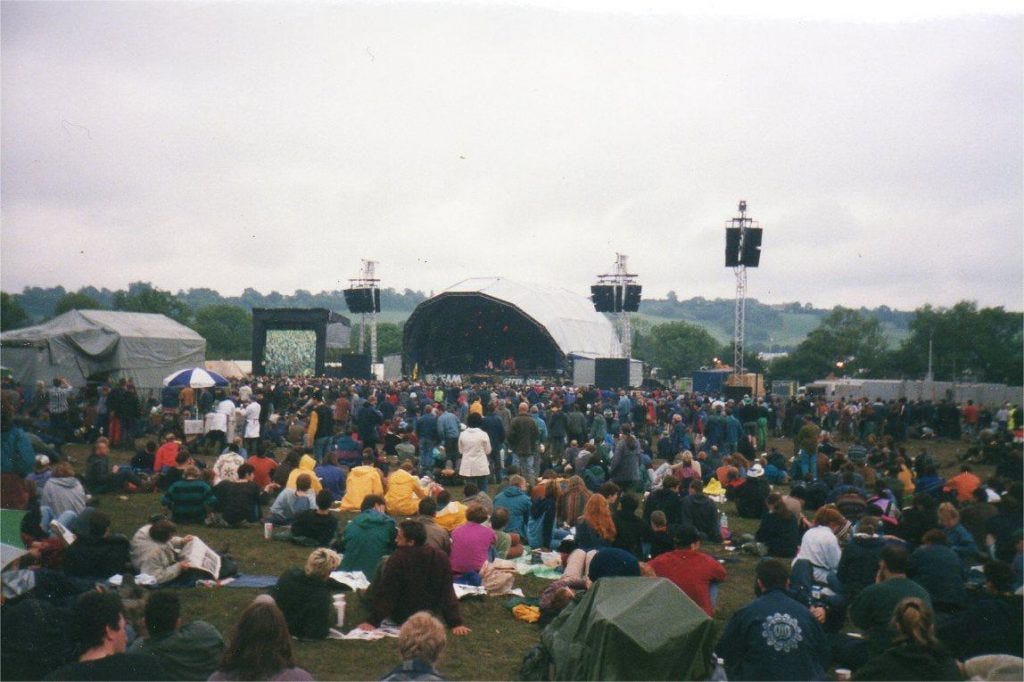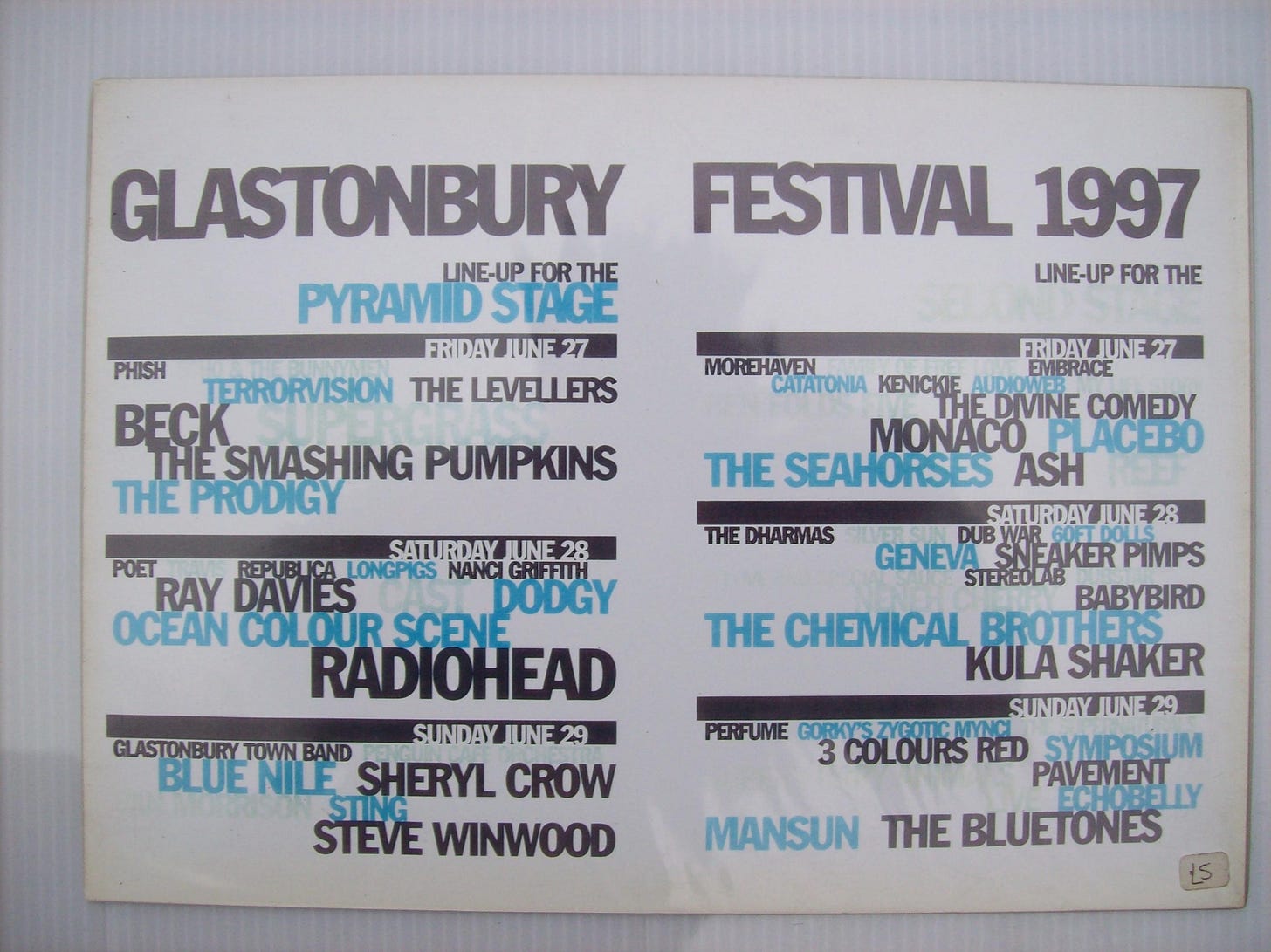Glastonbury
SET 1: Wilson > Chalk Dust Torture, Stash, Dogs Stole Things, Poor Heart > Taste, Bouncing Around the Room, Character Zero
Roskilde
SET 1: You Enjoy Myself, Taste, Bouncing Around the Room, Beauty of My Dreams, Chalk Dust Torture, Theme From the Bottom, Character Zero
ENCORE: My Soul
At the center of Phish’s Europe ‘97 calendar, they briefly left the clubs to play two of the continent’s oldest and biggest summer festivals. Glastonbury dates back to 1971, when a bunch of hippies built a pyramid-shaped stage on a farm near Stonehenge and invited David Bowie to headline. Roskilde started just a year later, founded by two enterprising high school students in the suburbs of Copenhagen. Today, these fests draw six figures of fans to their sites for four or five days of music on multiple stages; as I write this, their 39th and 52nd editions, respectively, are underway after two years of COVID cancellations.
In 1997, Phish could pack virtually any reasonably-sized arena in the United States, but they arrived at these mega-fests as a decidedly low-status act. Poster position is the ultimate arbiter, and while Phish makes the third out of four lines of the Main Stage on the Glastonbury lineup, you need a magnifying glass to find them on Roskilde’s. Set time is the other status symbol, and though they played the pyramid at Glasto, Phish had the ignominy of being the first band on the festival’s first day, playing at 10:30 a.m., several hours in advance of headliners The Smashing Pumpkins and The Prodigy. In Roskilde, they didn’t play the famous “Orange Stage,” but were tucked away in the second-tier Green venue, playing at 4pm between John Hiatt and Isaac Hayes.
As usual, Phish is hopelessly out of step with the pop culture trends these lineups capture. Glastonbury is naturally chock full of late-period Britpop, for better (a legendary OK Computer-era Radiohead set, which you can watch here) or very much worse (Kula Shaker, who replaced planned headliner Neil Young in one of the all-time worst downgrades). In Denmark, their placement suggests a classification as a “roots” band, somewhere between the Americana of Hiatt and the soul-funk of Hayes. Ultimately, they fail to fit in with either festival roster: too square for the alt-rockers, too weird for the throwbacks.
Phish tried to split the difference, but as usual, that ends up satisfying few. While they kept it pretty real and loose at the smaller German festivals the week before, for these high-profile appearances, they go back to the Europe ‘96 strategy of offering an hour-long sampler pack. The compromise approach is so deliberate, they actually repeat four songs – Chalk Dust, Bouncin, Zero, and Taste – between the two eight-song sets. In between, they sprinkle a little blues, a little bluegrass, and one song each night (Stash, YEM) that offers a brief glimpse of Phish improvisation.
The only risky swings are in the openers. At Glastonbury, they can’t resist the opportunity to play the song that name-drops Stonehenge, even if it creates the very sad scene of only a few people doing the Wilson chant. At Roskilde, they take the bolder step of leading off with the first YEM in four months, squashing rumors that their trademark song was on the shelved list. As I said, it’s a classic bit of self-sabotage — its proggy beginning scaring away anyone sticking around after John Hiatt, its trampoline funk-rock middle offending anyone arriving early for Black Moses, its vocal jam chasing off everyone in between.
Instead, Phish’s most effective calling card each night is a song that took them a long time in public to figure out, but which has now suddenly found its prime. Through 11 European shows, Phish have played Taste 8 times — as frequently as the heaviest-rotation new songs. And despite being over two years old and already enshrined on a record, Taste crackles in 1997 with fresh energy.
This peak comes despite Taste not really connecting to the broader themes of 1997. It’s not funky, its jam is organized into two distinct solo sections instetad of a collective improvisation, and it won’t go “Type II” for another 20 years. But there’s a slight structural resemblance between Taste and the Summer 97 freshmen. Though it sounds complicated all put together, the individual parts of Taste are fairly simple for musicians of Phish’s caliber. The trick lies in getting the timing just right and making their uneven rhythms combine into a cohesive and compelling aggregate (in this sense, the song always felt to me like a sibling to Radiohead’s “Let Down”...which they didn’t play the next night at Glastonbury).
But that part of Taste, as much as it influences new songs such as Limb By Limb, Twist, or Ghost, has always been there. The real factor that sets ‘97 Tastes apart is Trey’s solo section, which was added on to Page’s solo sometime in the previous year. Unlike Maze or Mule, this isn’t really a fair fight. Page’s piano feature is always a joy, but the Taste Trey solos are at another level, stretching out to 5-6 minutes even in these conservative festival sets. And these are not hollow virtuoso flash either; each note is thought out, a short story written in paragraphs, with the rest of the band providing telepathic accompaniment.
Anyone new to Phish at these festivals who stuck around long enough to hear Taste had the highest likelihood of getting hooked. Outside of their core constituency, Phish has eternally struggled to walk the tightrope between accessibility and honesty, even as they approached a career peak in 1997. Taste, though its not particularly representative of the time, is the song that satisfies both of those demands; a taste for free, if you will, to bring foreign festivalgoers under their spell.




